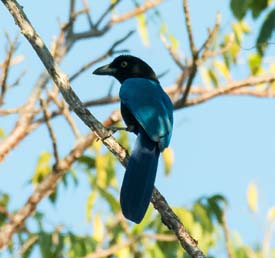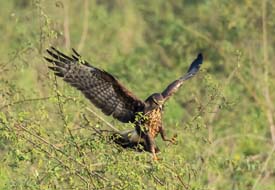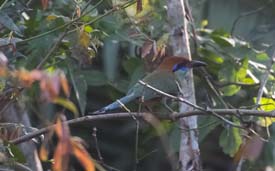Saturday was another early start. We were headed back up to the coffee plantation area, but stopped briefly on the way to check out a place in the small town below the plantation. It was pretty birdy and we found a bright-rumped attila.
We also had good looks at a scrub euphonia, and masked tityra.
Up at the coffee plantation we were less successful than on our previous visit. There were not nearly as many birds around, and when we finally heard a rosy thrush-tanager, we were totally unable to get it to come out for a viewing. After about 90 minutes we decided to try some new spots including a group of abandoned shrimp ponds. I had to take a picture of Dan Sanders in his house slippers scoping the ponds. He was having trouble with a sore toe, and decided to wear his slippers--this had to be a birding first for me.
The ponds were pretty productive for waders including our only reddish egret of the trip, and a couple of American avocets.
Later in the day we visited a place that had been good for gray-crowned yellowthroats. It did not disappoint, and we also had good looks again at white-collared seedeaters. We kept looking for ruddy-breasted seedeaters as well, but never found any that definitely could be identified.
We saw another laughing falcon, and finished our day hearing and finally getting a brief look at a lesser ground-cuckoo.
Most of day 9 was spent at a place called Tecuitata--a ridge road that we walked along for quite some distance. It was often shady, so the day was very delightful from a temperature point of view.
Our main target here was the San Blas jay which we did see initially at some distance, but then we were able to get much closer looks at this fine bird.
We saw many of the same birds we had seen during the trip like gray hawk, which was a daily bird for us, but also squirrel cuckoo, and rufous-backed robin.
Late morning a pick-up truck came by, and Dave had a short conversation with the people in it. He told us they were on the way over the hill to the beach. It turned out they had been hired by him to make us lunch which we discovered when we rounded a corner an hour later to find them cooking chili rellenos (photo taken by Laura Keene). This is a favorite Mexican dish for me, and these were the best I have ever eaten!
There were 2 huge fig trees on each side of our lunch table that kept dropping tiny figs on us. They also attracted lots of birds including a magnificent lineated woodpecker.
Our lunch spot looked out the the Pacific ocean, and at one point we watched a group of white pelicans soar by us.
After lunch we worked our way back down the road, and then went back to San Blas to take a very short boat ride over to Peso Island. It is called Peso Island because it originally cost 1 peso to ride over on the boat. Inflation of course has now raised the price to 20 pesos/person.
It was a very pretty weekend afternoon so you would have thought there would be lots of people on the beach. To our surprise we had the place to ourselves. Dave told us that other than Easter week, Mexicans do not spend time on the beach. A group of 15-20 Wilson's plovers popped up.
There was of course a gull flock that had terns mixed in, and also we found the ubiquitous ruddy ground dove. We walked out to the breakwater, and figured we could just walk back along the beach to the boat, but discovered that was not possible half way along. This caused us to cut through a pasture while fighting off the mosquitos that were coming out as the sun set.
It was hard to believe that Monday was already day 10, and our last day of birding. Before making the drive back up to Mazatlan, we had another boat trip which went up the Rio San Cristobal. We were on the river early on a blue sky day with a nice breeze.
Green kingfishers and black-crowned night-herons were seen often.
We had been hoping to find mangrove cuckoos, so we were pleased to get very good looks at one.
We saw more snail kites, and had a close up fly over from a roseate spoonbill.
We also got to view a wood stork rookery.
We still had 2 other target birds to find--spotted rail and hook-billed kite. We took our boat into a side channel that opened up into a large shallow wetland. When we heard a spotted rail calling, we worked for quite some time to draw it to us. As it moved closer and closer making intermittent calls, we did see common gallinule and a Ridgeway's rail. We also had 2 hooked-billed kites fly across the open area at some distance giving very unsatisfying looks for those of us who were facing in the right direction as they quickly passed us.
After maybe 20 minutes of patiently waiting, the spotted rail stuck its head out of the vegetation very near our boat, but when it looked up and saw us, it immediately turned around, stopped calling and disappeared. Unfortunately not all of our group was able to see it.
We needed to make our way back to the boat dock, and then return to the hotel for a final meal before starting for Mazatlan. We were on the road by about 1 PM for the 3+ hour drive. We decided to make one last stop at a place we had visited on day 1. Our target birds were rosy thrush-tanager and flammulated flycatcher. 2 or 3 of our group briefly saw the thrush-tanager, and all of us had good looks at the flycatcher.
We returned to Hotel Siesta in Mazatlan for our last night. We enjoyed one more meal together drinking margaritas and cold Mexican beer. We all were very happy to have had such a good trip together, and particularly to have seen so many birds that are only seen rarely and often not very well in the ABA birding area. We had such good views of some of these birds that we started talking about not life birds for our lists, but life looks meaning the best view we had ever had of a species. The total species count of seen and/or heard birds came to 299. I know that I saw over 50 new life birds.
As the meal wound down, we said our good-byes because Dave was taking Neil, Dan and Doreene to the airport at 4:30 AM, and then driving home to Alamos. Bert, Laura, Marty and I were not flying out until 11:45 AM. I would highly recommend this trip guided by Dave to anyone wanting to dip their feet into what birding in Mexico has to offer.
Thursday, April 7, 2016
Friday, April 1, 2016
San Blas, Mexico 2/24-26/16
On Wednesday morning we were up at 5 for breakfast and on the road by 5:30 to make the drive up into a coffee plantation that was no longer fully managed. The elevation took us up out of the sea level habitat. The bird viewing for the first hour was very active, but they were quite high up in the trees. Golden-cheeked woodpeckers were abundant. Other highlights included bat falcon, elegant euphonia, elegant and citreoline trogons, rufous-backed robin, happy wren, and western tanager.
The road through the plantation was a fairly rough cobblestone type that seemed very old, and very necessary if it has been raining. We worked our way down the road, stopping and scanning as best we could through the heavy foliage. We picked up lilac crowned parrot, and saw gray-crowned woodpecker; greenish elaenia; boat-billed flycatcher; ivory-billed woodcreeper; western long-tailed hermit; and red-crowned ant-tanager. Like most days of our trip we heard collared forest-falcon, but never once did we see one. Other heard only birds that morning included russet-crowned motmot, and colima and ferruginous pygmy owls.
After our siesta we visited crocodilo road which gave us a wide variety of bird life beginning with our first bare-throated tiger-heron of the trip.
We also had a northern jacana.
Groove-billed anis were around.
The first laughing falcon of our trip made an appearance, as did a black hawk.
Driving into San Blas yesterday Dave had seen a crane hawk fly over that the rest of us missed, so we were very glad when one come by.
Other birds seen along the road included white-throated, willow and vermilion flycatchers; white-collared seedeater; lincoln sparrow; thick-billed and tropical kingbirds; orange-crowned, nashville, Macgillivray's, Wilson's and yellow warblers; and mangrove and northern rough-winged swallows. After a long and pretty toasty afternoon, we were more than ready to get back to the hotel for beers and dinner.
We were up even earlier on Thursday because we had to drive over an hour to a mid elevation site for our morning birding. The area is called Cerro de San Juan. Our main targets were various hummingbirds. There were of course several white-eared, but we also picked up berylline.
The others included calliope, cinnamon and finally a bumblebee. The best though was the Mexican woodnymph.
Two birds that had been eluding us were the rufous-crowned ground-sparrow, and the rusty sparrow.
We stopped at a high altitude ranch that had a large group of spotted wrens, and along the road we found our first stripe-headed sparrow of the trip.
After a picnic lunch in the cool highlands where we saw our first green jays of the tour as well as several warbler species like black-throated gray, yellow-rumped and rufous-capped, we drove down to sea level to find a marshy area that Dave had heard about. We wandered around on back roads a bit before we finally located it, but it was well worth it.
There were a large number of black-bellied whistling ducks, but most amazing was the huge number of female and immature snail kites.
There were also many limpkins.
As the sun fell low in the sky, we made our way back to the hotel for more beer and good food which this time of year meant lots of variations on wild caught shrimp from the Pacific ocean (photo taken by Laura Keene).
Friday morning was not quite such an early start, but we were still on the road before 6 AM. Our morning was spent walking along Singayta Road. Since we were now on our 7th full day of birding, and 3rd in the San Blas area, the number of new species for us was beginning to decline. The morning was very delightful nevertheless. Some previously seen birds included golden-cheeked and gila woodpeckers; great kiskadee; red-billed pigeon; white-winged, white-tipped, and inca doves; groove-billed ani; cinnamon hummer; orange-fronted parakeet; and dusky, pacific-slope, and social flycatchers.
New seen birds for the trip included a great black-hawk, fan-tailed warbler, Mexican parrotlet, and russet-crowned motmot.
After our siesta we all piled into a small boat for a late afternoon until dark trip on Rio Tovara. The first part had us follow the river out to its mouth. Along the way we stopped and called out a rufous-necked wood-rail. I also briefly saw a jaguarundi walking along the far side of the river, but it moved into the vegetation before I could get anyone else on it.
The main reason for the boat trip was to go up river through the mangroves to the large spring that feeds the river. It was a beautiful evening, and with all the bird life it turned into a very magical time.
The number one goal was to find one of the strangest of birds--the boat-billed heron. We located 2 roost areas. A truly stunning bird, but such an odd bill.
Near dusk we found a white-tailed kite. Just before that we had an unusual encounter with a merlin that circled over our boat time and again before finally disappearing. We almost felt like the bird was dive bombing us.
The other most interesting bird of the evening was the northern potoo. Over an hour's time we encountered 8 of them. It seems like the perch goes right into its stomach since you can not see its feet. We also flushed a few paraques.
We ate later than normal, but no one was complaining after such a perfect tour of the river.
The road through the plantation was a fairly rough cobblestone type that seemed very old, and very necessary if it has been raining. We worked our way down the road, stopping and scanning as best we could through the heavy foliage. We picked up lilac crowned parrot, and saw gray-crowned woodpecker; greenish elaenia; boat-billed flycatcher; ivory-billed woodcreeper; western long-tailed hermit; and red-crowned ant-tanager. Like most days of our trip we heard collared forest-falcon, but never once did we see one. Other heard only birds that morning included russet-crowned motmot, and colima and ferruginous pygmy owls.
After our siesta we visited crocodilo road which gave us a wide variety of bird life beginning with our first bare-throated tiger-heron of the trip.
We also had a northern jacana.
Groove-billed anis were around.
The first laughing falcon of our trip made an appearance, as did a black hawk.
Driving into San Blas yesterday Dave had seen a crane hawk fly over that the rest of us missed, so we were very glad when one come by.
Other birds seen along the road included white-throated, willow and vermilion flycatchers; white-collared seedeater; lincoln sparrow; thick-billed and tropical kingbirds; orange-crowned, nashville, Macgillivray's, Wilson's and yellow warblers; and mangrove and northern rough-winged swallows. After a long and pretty toasty afternoon, we were more than ready to get back to the hotel for beers and dinner.
We were up even earlier on Thursday because we had to drive over an hour to a mid elevation site for our morning birding. The area is called Cerro de San Juan. Our main targets were various hummingbirds. There were of course several white-eared, but we also picked up berylline.
The others included calliope, cinnamon and finally a bumblebee. The best though was the Mexican woodnymph.
Two birds that had been eluding us were the rufous-crowned ground-sparrow, and the rusty sparrow.
We stopped at a high altitude ranch that had a large group of spotted wrens, and along the road we found our first stripe-headed sparrow of the trip.
There were a large number of black-bellied whistling ducks, but most amazing was the huge number of female and immature snail kites.
There were also many limpkins.
As the sun fell low in the sky, we made our way back to the hotel for more beer and good food which this time of year meant lots of variations on wild caught shrimp from the Pacific ocean (photo taken by Laura Keene).
Friday morning was not quite such an early start, but we were still on the road before 6 AM. Our morning was spent walking along Singayta Road. Since we were now on our 7th full day of birding, and 3rd in the San Blas area, the number of new species for us was beginning to decline. The morning was very delightful nevertheless. Some previously seen birds included golden-cheeked and gila woodpeckers; great kiskadee; red-billed pigeon; white-winged, white-tipped, and inca doves; groove-billed ani; cinnamon hummer; orange-fronted parakeet; and dusky, pacific-slope, and social flycatchers.
New seen birds for the trip included a great black-hawk, fan-tailed warbler, Mexican parrotlet, and russet-crowned motmot.
The main reason for the boat trip was to go up river through the mangroves to the large spring that feeds the river. It was a beautiful evening, and with all the bird life it turned into a very magical time.
The number one goal was to find one of the strangest of birds--the boat-billed heron. We located 2 roost areas. A truly stunning bird, but such an odd bill.
Near dusk we found a white-tailed kite. Just before that we had an unusual encounter with a merlin that circled over our boat time and again before finally disappearing. We almost felt like the bird was dive bombing us.
The other most interesting bird of the evening was the northern potoo. Over an hour's time we encountered 8 of them. It seems like the perch goes right into its stomach since you can not see its feet. We also flushed a few paraques.
We ate later than normal, but no one was complaining after such a perfect tour of the river.
Subscribe to:
Posts (Atom)


























































